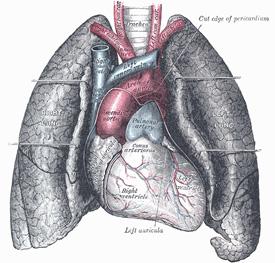
Front View of Heart and Lungs
Q: Got a friend (a smoker) who ended a camping trip in the mountains (probably around 6K feet) by getting a collapsed lung. His wife got him to the hospital and all is well--he is even back to enjoying his electronic cigarettes (says it is not really smoking!) Anyway, I was thinking of using this as an opportunity to (finally) get him to try breathing meditation, Yoga/Tai Chi—but the lung thing has me worried. This was spontaneous with no obvious indications of why it happened or if it will happen again. He does nothing half-way, this guy, so if I get him doing deep-breathing exercises he will be going for the max. Is there a danger of the collapse happening again or can we use deep breathing to strengthen his lungs?A: Thanks for writing to us about your friend’s condition. As always, the information I will share is of a general nature and in no way a prescription for how you will want to work with your friend. But I hope the following discussion will give you more information to work with as you try to help your buddy.
Let’s start with the condition that your friend developed. He has what is called a spontaneous pneumothorax (SP), when air gets in between the lungs and the space around the lungs—not a natural state of affairs—resulting in a change in air pressure inside the chest cavity, with the air pushing on the lung. The lung subsequently collapses a little or a lot and leads to chest pain and shortness of breath of varying degrees, depending on the size of the collapse. With a small, uncomplicated collapse, the person's lung may quickly heal on its own.
Although pneumothorax can occur for no obvious reason, as a cigarette smoker, your friend would be at higher risk for this right away. Known causes of SP include a chest injury, underlying lung disease or ruptured air blisters (blebs). According to the Mayo Clinic website, the following are risk factors for the development of SP:
- Gender. In general, men are far more likely to have a pneumothorax than are women.
- Smoking. The risk increases with the length of time and the number of cigarettes smoked, even without emphysema.
- Age. The type of pneumothorax caused by ruptured air blisters is most likely to occur in people between 20 and 40 years old, especially if the person is a very tall and underweight man.
- Genetics. Certain types of pneumothorax appear to run in families.
- Lung Disease. Having an underlying lung disease, especially emphysema, pulmonary fibrosis, sarcoidosis and cystic fibrosis, makes having a collapsed lung more likely.
- Mechanical Ventilation. People who need mechanical ventilation to breathe effectively are at higher risk of pneumothorax.
- History of Pneumothorax. Anyone who has had one pneumothorax is at increased risk of another, usually within one to two years of the first episode. This may occur in the same lung or the opposite lung.
So what do I think would be a reasonable approach of yoga breath techniques for SP? We do know from a few studies done in India that yoga practices, including pranayama, can be helpful for other lung conditions like asthma and emphysema. That means yoga has been used safely in other people whose lungs that don’t work quite right. To me, this is very encouraging about the overall safety of yoga for lung diseases. One possible unwanted result of someone having a SP might be a reluctance to take even a normal inhalation due to fear of a recurrent collapse. However, practicing a gradual increase in the length of the inhalation and exhalation while monitoring for pain or shortness of breath could effectively re-establish a person’s pre-SP breathing ability. And if you encouraged the breathing to have a gentle quality on both the inhale and exhale portions of the breath cycle, you could also eventually improve the overall deep breathing capacity of your student.
It would likely be important if your student has a type-A personality to observe his breathing while you teach him the technique to verify that the breath is not aggressive in any way. If you yourself do not do a lot of pranayama in your own practice, I’d really recommend that you find an experienced teacher to work with your student.
As things progress, your friend may be able to do the modern three-part breath that is very commonly taught in all levels of yoga classes in the US (you start by imagining you are filling the belly first, then the lower chest second, and finally the upper chest last, but in one continuous breath without a pause). It is also possible that once a good three-part breath is established, teaching a very mild form of ujjayi breathing could be helpful. Ujjayi mimics the effect of using a device called a spirometer that is used in a different lung condition called atelectasis, which is more a problem inside the lung’s tiny air sacs the alveoli, not a result of a collapsed lung specifically. Again, I’d have the student create a very quite ujjayi sound as you monitor his work for a while to ensure he is keeping it on a more gentle level.
So, to recap, you could gradually reintroduce the three-part breath. Once that is safely accomplished, you might add in some gentle ujjayi to the three-part breath. And with all beginning breath teaching, I’d recommend starting off with the student lying supine to learn these techniques. To be on the safe side, avoid holding the breath at the top of the inhale, and also the bastrika and kapalabhati forms of pranayama.
—Baxter

